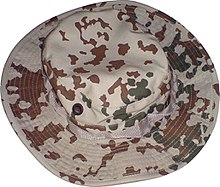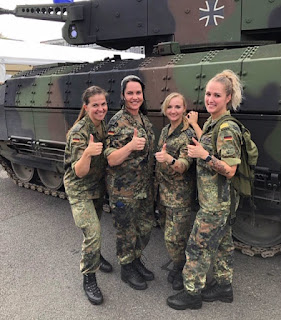Flecktarn (German pronunciation: [ˈflɛktaʁn]; "mottled camouflage"; also known as Flecktarnmuster or Fleckentarn) is a family of 3-, 4-, 5- or 6-color disruptive camouflage patterns, the most common being the five-color pattern, consisting of dark green, light green, black, red brown and green brown or tan depending on the manufacturer. The original German 5-color pattern was designed for use in European temperate woodland terrain. A 3-color variation called Tropentarn (formerly Wüstentarn) is intended for arid and desert conditions: the German Bundeswehr wore it in Afghanistan.
The original German 5-color flecktarn has been adopted, copied and modified by many countries for their own camouflage patterns.
Modern patterns[edit]
In 1976, the Bundeswehr in Germany developed a number of prototype camouflage patterns, to be trialled as replacements for the solid olive-grey "moleskin" combat uniform. At least four distinct camouflage patterns were tested during Bundeswehr Truppenversuch 76 ("Bundeswehr Troop Trial 76"). These were based on patterns in nature:[2] one was called "Dots" or "Points"; another was called "Ragged Leaf" or "Saw Tooth Edge"; another was based on pine needles in winter.[2]
Designed by the German company Marquardt & Schulz, several patterns were developed and tested by the German military. The pattern named "Flecktarn B" was chosen as the final pattern for use. The word flecktarn is a composite formed from the German words Fleck (spot, blot, patch or pattern) and Tarnung (camouflage). The Bundeswehr kept its green combat dress throughout the 1980s, however, while trials were conducted. Flecktarn was only widely introduced in 1990 in a newly reunited Germany.[2]
Tropentarn, formerly known as Wüstentarn, is a camouflage pattern used by the Bundeswehr in arid and semi arid regions.[1] It is the desert variant of the Flecktarn 5-color temperate climate camouflage print of the Bundeswehr.
Tropentarn's official name is 3 Farben-Tarndruck der Bundeswehr (3-color camouflage print of the Bundeswehr) – Instead of the 5-color scheme of greens, brown, and black of temperate Flecktarn, Tropentarn uses only three colors: a base color of 70% khaki tan with 20% medium brown and 10% dark green spots.[2]
 |
| Multicam camo |

































Cap comentari:
Publica un comentari a l'entrada